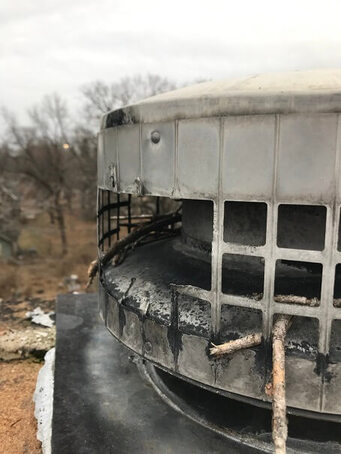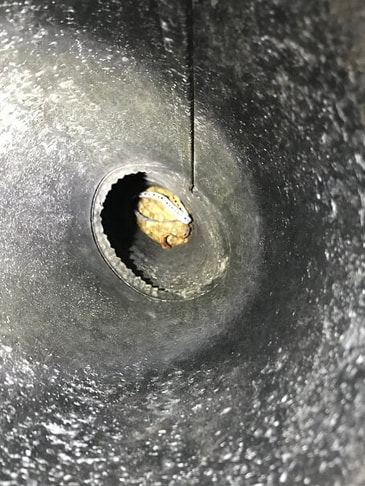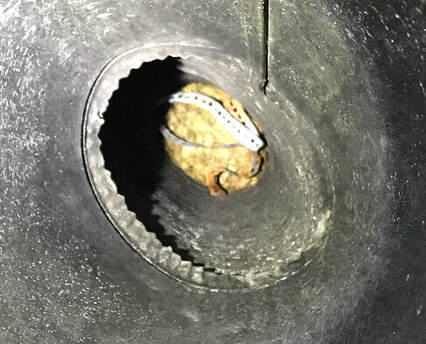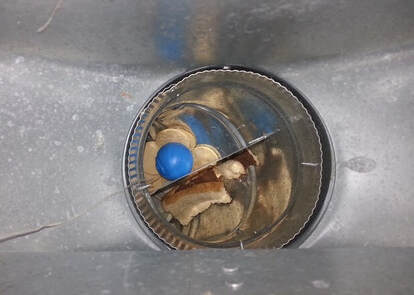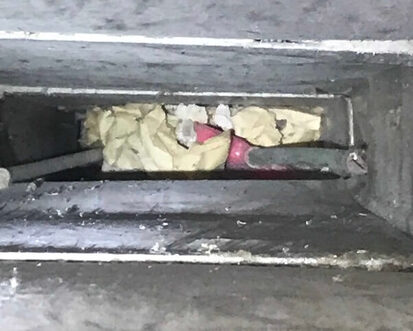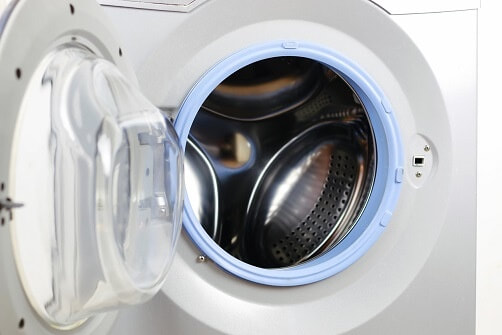|
Can you guess what caused the damage to the below flue cap? Before we identify the culprit, a few words about the importance of caps. Chimney or flue caps are indispensable for protecting the integrity of your chimney interior and maintaining air flow and draft. They do so by preventing the infiltration of rain and snow into your flue, which can cause water damage, and by preventing (or minimizing) the entry of animals, who bring with them lots of flue-clogging nesting debris. The problem This month a homeowner in St. Paul had their power company out to do a routine pre-season check on their boiler. To their surprise, it was red-tagged and shut down, after a determination that their boiler flue was clogged. This left the homeowner without heat in the cold of a Minnesota November. They called several companies seeking to have a boiler flue cleaning, but because of the cold and wet conditions, and the pitch and height of their roof, they were repeatedly turned down. Their roof's pitch was 10/12, and a 32-ft ladder fully extended was required just to get to the roof line. From there it was another 15 feet to the top of the chimney. The diagnosis When our technician arrived on the job, he first read through the notes from the gas company, who had indicated there was a backdraft from the flue, presumably due to a blockage, to such an extent that some of the plastic components on the top of the water heater had melted (the water heater and boiler shared a flue). The technician began by disassembling the portion of the flue located in the basement, where the flue enters the chimney stack, expecting to immediately find a blockage there—but there was none. This area is typically where clogs are found—at the elbow where the flue goes from horizontal to vertical after entering the brick. Animals frequently nest in this area due to its warmth. But this occurrence is extremely rare when a cap is in place over the flue, which was the case with this home. All of this left our technician a bit stumped. To further his investigation, he climbed the roof for a closer look. On reaching the top, he observed that a very determined animal had gnawed through the screening of the aluminum chimney cap. On removing the mangled cap and peering down the chimney, our technician spotted the problem: an enterprising squirrel had constructed a nest a quarter of the way down the flue, causing a complete obstruction. This would have blocked the exit of dangerous carbon monoxide produced by the boiler, and thus the red-tagging by the gas company. Cell-phone images taken from on-high have their limitations, but here's a bit of a closer look: The solution
The technician began the job of removing the obstruction by using a Viper GFK Chimney Cleaning System, which features a coiled rod—65 feet fully extended—to which brush heads of various sizes and materials (poly or steel wire) can be attached. He inserted the poly brush into the flue from above, attempting to push through the nest. His assistant was below, capturing the falling mess—the smaller debris with an industrial vacuum, the larger debris with his hands. After managing to get the poly brush all the way through the nest and down to the elbow—almost 50 feet from the top of the chimney to the basement--the tech switched to the steel brush to finish the job (the poly brush was successful in removing only about a quarter of it). After 45 minutes, they managed to remove the entirety of the nest and ended up filling a 5-gallon bucket with nesting debris, mostly consisting of large sticks and grass clippings. On completion, daylight was observed from down below, entering through the top of the flue. When a lighter was held at the opening, the flame was pulled toward it, indicating proper draft. The homeowner was assured that the flue was clean and clear of debris and that it was safe to call the gas company and get the appliance turned back on. Before leaving, the technician placed a new type B gas vent cap on top of the flue. The lesson Unfortunately, there isn't really a huge insight to reveal here. In our technician's almost 20 years of experience, he had never observed a capped flue that suffered such an obstruction. (Uncapped flues are another story altogether.) By ensuring that each of your flues has a cap, you reduce the chances of animal intrusion to almost zero. Checking the fit and condition of your cap occasionally, or having someone else do it, will virtually guarantee your flue remains unobstructed, and elevate you to super-homeowner status. Wanna learn more about utility flue cleaning? Visit our flue cleaning service page. Learn More Many thanks to our technician Ben S for lending his expertise to this article.
0 Comments
It's understandable that when taking up residence in a new home you'd want to start from a clean slate, so to speak. You want the house you move into to be spotless so you can make it your own. If it has not been cleaned prior to your arrival, for example, you wipe its floors and countertops before you begin unpacking your boxes. After all, it's one thing to live with your own dirt, but quite another to live with someone else's. This line of thinking leads lots of people to wonder whether they should have the air ducts cleaned when moving into a new residence. Here are a few things to consider to help make the call. First, a word about some of the goodies our technicians find inside HVAC ductwork: lots of things you can imagine, and some that would never enter your mind. These finds range from the benign (Legos, marbles) to the disgusting (garbage, dead animals, rodent feces, dirty diapers) to the dangerous (guns, traps, needles, etc). This is on top of the everyday grossness present in uncleaned air ducts, such as pet dander, dust mites, construction dust, and lots of other fun things. The scenario pictured above is common in households with children—lots of food items shoved down the vent ("I wonder what would happen if I put this in here . . ."), including in this case a partially consumed peanut butter and jelly sandwich. The curiosities below were found inside the ductwork of a house in Minneapolis that was being flipped. Over the years the various residents had dropped all manner of debris—including crumpled paper, garbage, and a broken broom handle--down the floor vents. Because in most cases you don't have detailed knowledge of who inhabited your home before you and what they did there, it's wise to consider having a thorough duct cleaning performed on move-in. Sometimes, to increase the attractiveness of the home to buyers, the seller will have the ducts cleaned before putting the house on the market. Even if this is the case, a more thorough cleaning may be desired. Air duct cleaning typically is offered in "good," "better," and "best" options, and the difference between them can be significant. It's not typical for homeowners to select the top-tier service if they know they're on their way out.
But what if you're moving into a newly constructed home? In most of these cases, too, a thorough duct cleaning is warranted. Our technicians remove all manner of construction debris from the ducts of newly built homes, including concrete chunks and other building materials, and most insidiously, drywall (aka Sheetrock) dust. Drywall dust is ubiquitous in newly built or remodeled homes, and it is notorious for infiltrating every component of the HVAC system and choking off the air flow that is so vital to HVAC system efficiency. It settles as a fine, chalk-like powder in the ducts and is recirculated throughout the system, polluting indoor air and dirtying the living space. Some conscientious builders, for the above reasons, will commission a top-of-the-line air duct cleaning on completion of the home. This is of course the ideal scenario. Other builders will unfortunately order only a standard cleaning when circumstances really warrant a higher level. All this is to say that if you are moving into a new home and want a fresh, clean start—out with the old occupants (and their dirt) and in with the new—consider adding air ducts to your list of spaces that warrant cleaning. Then you can have peace of mind that your whole house—its living space and its inner workings—is as clean as it can be. Wanna dig deeper? Download our free tipsheet: 10 Questions to Ask Before Hiring an Air Duct Cleaning Company. Download Tipsheet Many thanks to our technician Roy S for lending his expertise to this article. What is dryer vent cleaning? Ask someone what dryer vent cleaning is and you may be surprised by how many are under the impression that it means emptying the lint trap compartment. It's a forgivable error. Lots of homeowners, especially new ones, are surprised to find that cleaning the dryer vent—or more precisely, the dryer vent line--is a critical task for the sake of unit maintenance, but more importantly, for fire prevention. For the record, dryer vent cleaning is the removal of lint and debris buildup from inside the dryer vent line--the pipe or duct that runs from the back of your machine all the way through to the outside vent. Why is dryer vent cleaning necessary?
The National Fire Protection Association (NFPA) warns that "the leading cause of home clothes dryer fires is failure to clean them." Thanks to organizations such as the NFPA, local fire departments, and dryer vent cleaning companies, awareness of the importance of cleaning your dryer vent is increasing. So, why is it necessary? With every load of laundry you run, small bits of cloth loosen from your clothes and end up in the machine. The lint trap catches a good amount of this debris, but some of it invariably ends up in your dryer vent line. This lint, which is extremely combustible, builds up over time, reducing air flow and, in sufficient quantities, creating a fire hazard. Its removal is essential to the smooth—and safe--functioning of your dryer. How are dryer vents cleaned? The most common method (and that embraced by lots of DIYers) utilizes a brush head attached to flexible rods that are fed into the dryer vent line incrementally, adding length as the distance increases. The rods are powered by a handheld drill that serves to rotate the rod-and-brush combo inside the vent line, loosening lint and pushing it out (or pulling it in) the other side. This method can be successful for most vents, especially those that are shorter or do not contain many turns. A more effective method (we've found) utilizes a spinning skipper ball with reverse-blowing air nozzles. The tool is fed through the vent line from the outside until it reaches the dryer. Once engaged, the ball spins around and shoots out air behind it, toward the vent (thus "reverse-blowing). As the tool is pulled toward the technician, the lint is blasted out with it. When should I have my dryer vent cleaned? Frequency of cleaning will depend on household size and how often you use your dryer. The ideal home maintenance schedule would include a yearly dryer vent cleaning. Spring or summer is the best time of year for the service if you have a rooftop vent, so the technician does not have to negotiate an icy roof (most won't). Some indications you're due for a cleaning are if your clothes are taking longer than usual to dry or if your machine (or the laundry room) feels hotter than normal. One of the surest ways to tell if there's a clog in your vent line is to check for airflow from the outside vent when the dryer is running. Is the flap being pushed open? Is warm air coming out? No sign of air flow is cause for concern. How much does dryer vent cleaning cost? Pricing on cleaning out a dryer vent tends to vary less than for some other HVAC cleaning services, like air duct cleaning. That's because in most cases, it is relatively straightforward, allowing most companies to use the same process or tool for each situation. With that said, however, there are a few factors that can affect pricing. The number one reason you'll be charged more for the job is if your dryer vent is difficult to reach or on the roof, which entails more risk and liability. Some companies also charge more for a longer vent line or multiple turns. At any rate, the price for having your dryer vent cleaned is negligible when compared to the possible cost of not doing so! Wanna dig deeper? Download our free tipsheet: 5 Questions to Ask Before Hiring a Dryer Vent Cleaning Company. Download Tipsheet Many thanks to our technicians Ben and Kris for lending their expertise to this article. |
SearchArchives
April 2022
|
Twin Cities Furnace Cleaning - Open 7 Days a Week 8AM to 8PM

